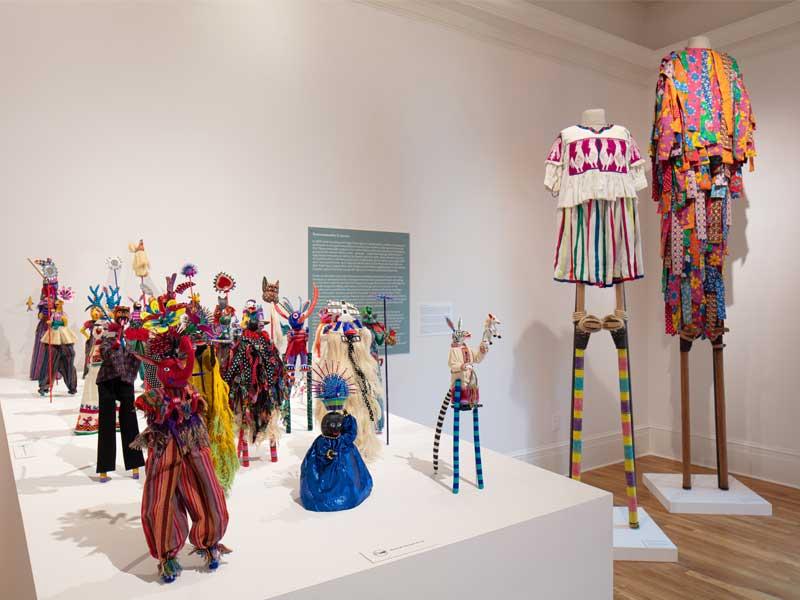Newcomb Art Museum announces spring lineup of programs
This past January, Newcomb Art Museum opened its latest show Laura Anderson Barbata: Transcommunality – which presents five collaborations across the Americas that blend political activism, street theater, sculpture and arts education – with a digital tour, artist talk and virtual 3D walk-through. Though currently closed to off-campus visitors, Tulanians can visit the museum Wednesdays and Fridays from 9:30 a.m. to 12 p.m. Continuing the tradition of creating unique ways to connect with the show safely at home, the museum has lined up a variety of free programs for the spring and invites all visitors to mark their calendars for new ways to engage with Transcommunality.
In February, revisit Newcomb’s fall program Been Here, which features an audio conversation with Mia X and Melissa A. Weber on hip hop and New Orleans music. Releasing Feb. 10 on the museum’s website, Facebook and newsletter, visitors can watch a video recording of this engaging exchange and learn why certain stories are included in those histories and why some stories get overlooked.
On Feb. 25, join the museum for Reimagining Public Safety in American Cities via the Zoom link here. This virtual program, presented in partnership with The Phyllis M. Taylor Center for Social Innovation and Design Thinking at Tulane, will respond to ideas presented in Anderson Barbata’s Intervention: Indigo, which addresses from an intercultural perspective, the symbolism of protection embodied by the color blue. The event will be moderated by Lesley-Ann Noel of the Taylor Center, Brent Godfrey of Crescent City Corps, Ameca Reali of Law For Black Lives, and Christopher Rabb of the Pennsylvania state House of Representatives. Using design thinking strategies to address the harms of over-policing, this discussion will open an transdisciplinary conversation that includes perspectives on public law enforcement, behavioral health, the Movement for Black Lives and U.S. history to posit a future of public safety.
On March 20, art lovers of all ages will be invited to take part in the museum’s virtual Family Day: Story Making, World Building. Artists will lead workshops that use cave paintings – the first known art form and created to tell stories – as an inspiration to make art. Family and friends can participate in a unique day of storytelling and creation. The event will be streamed live at 10 a.m. via the museum’s website, Facebook and newsletter.
Also in March – timed in conjunction with Tulane’s 3rd Annual Indigenous Symposium – a re-issue of Newcomb’s Fall program, On Remembering, a discussion with Monique Verdin and Rachel Breunlin, will be presented. The discussion will focus on how to remember, celebrate and continue to act for the people of Bulbancha: the Land of Many Tongues, the indigenous name for New Orleans.
In April, the museum will host Uncommon Exchanges in partnership with A Studio in the Woods, The ByWater Institute at Tulane University and New Orleans Center for the Gulf South. This unique dialogue between the pairings of Tulane and Gulf South artists and scholars will use the museum’s current exhibition as a catalyst for conversation working toward remedying missing narratives and providing paths forward – through creative means – to a more equitable and just future. Zoom registration is forthcoming.
In May and June, Newcomb Art Museum will present Louisiana Reimagines: High Culture Below Seas, a three-part exchange between Laura Anderson Barbata and local tradition bearers from the Black Masking Indian tradition responding to the garments and stilt dancing projects presented in Transcommunality. Offering a look into the cultural world of Big Chief Shaka Zulu of the Golden Feather Hunters, the program is centered on Shaka’s distinct yet ever-evolving New Orleans practice which combines procession, drumming, elaborate 3D suits, and West African stilt dancing. In Reciprocal Exchanges, local artists and culture bearers will exchange techniques and practices in the spirit of Laura Anderson Barbata’s Transcommunality and an economy of sharing. Each exchange – centered on wearable art – will be released as a short film, showcasing the artists’ practices and opening new creative possibilities through engagement. For both programs, details on how to view and engage will be released via the museum’s website and e-newsletter.
All programs are funded in part under a grant from the Louisiana Endowment for the Humanities, the state affiliate of the National Endowment for the Humanities. Any views, findings, conclusions or recommendations expressed in the program do not necessarily represent those of the National Endowment for the Humanities. The programs are also supported in part by a New Orleans Jazz and Heritage Foundation Community Partnership Grant and by a Community Arts Grant made possible by the City of New Orleans and Arts Council New Orleans.

